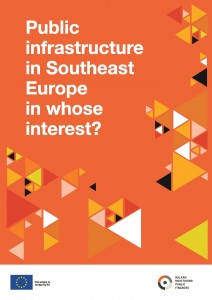Public Infrastructure projects in Southeast Europe marred by lack of transparency and risk of corruption
Skopje, 16 April 2018
Public infrastructure is meant to serve the needs of the general public. However, infrastructure projects are often not primarily designed with this in mind. Sometimes they result from pressure from investors; often they are genuine but misguided, or corrupted attempts to solve real issues, and sometimes they are vanity projects. Often, they are a combination of all of the above.
 The regional study of public infrastructure projects shows that infrastructure projects are often marred by lack of transparency and risk of corruption. There is a lack of public debate when public infrastructure projects are selected on a strategic level. Priorities are pre-decided by the authorities and almost never changed as a result of consultations. Public consultations, where they take place at all, are done at a very late stage when the decision to go ahead with the project has already been made. “Strategic” projects are usually anything but strategic and governments rarely provide compelling evidence in favor of prioritizing these projects. Often it is mainly domestic and international construction companies who benefit from projects rather than the wider public. Environmentally harmful options like coal power plants, motorway construction, and waste incineration still dominate investments. Although financing is available for eg. rail, wind and solar and recycling, governments in the region are not taking advantage of this.
The regional study of public infrastructure projects shows that infrastructure projects are often marred by lack of transparency and risk of corruption. There is a lack of public debate when public infrastructure projects are selected on a strategic level. Priorities are pre-decided by the authorities and almost never changed as a result of consultations. Public consultations, where they take place at all, are done at a very late stage when the decision to go ahead with the project has already been made. “Strategic” projects are usually anything but strategic and governments rarely provide compelling evidence in favor of prioritizing these projects. Often it is mainly domestic and international construction companies who benefit from projects rather than the wider public. Environmentally harmful options like coal power plants, motorway construction, and waste incineration still dominate investments. Although financing is available for eg. rail, wind and solar and recycling, governments in the region are not taking advantage of this.
Most financial support for infrastructure in Southeast Europe comes from EU sources and multilateral development banks. The European Investment Bank claims to be the largest international investor, with financing worth EUR 6.4 billion since 2006, the majority of which is dedicated to small and medium enterprises, but also to infrastructure projects, particularly transport. The European Bank for Reconstruction and Development mostly concentrates on infrastructure and credit lines. Other sources of infrastructure financing in the region include China, Russia, Turkey and other sources from the Middle East. For now, the EU and multilateral sources still dominate in energy and transport, but the importance of other actors is growing.
To hear what experts from the European Investment Bank, Bankwatch, The Energy Community Agora Energiewende have to say about the EU’s role in infrastructure planning and financing in SEE and what lessons can be learned from infrastructure cases in SEE from the perspective of local NGOs from Serbia, Macedonia and Bulgaria, attend our event “Public infrastructure in Southeast Europe – in whose interest?”. The event will be held on April 17 at 9:15 in Best Western Hotel Turist, Gjuro Strugar street 11, Skopje.
The Agenda can be found here: Infrastructure_Skopje_final

 LOKALNI JEZIK
LOKALNI JEZIK